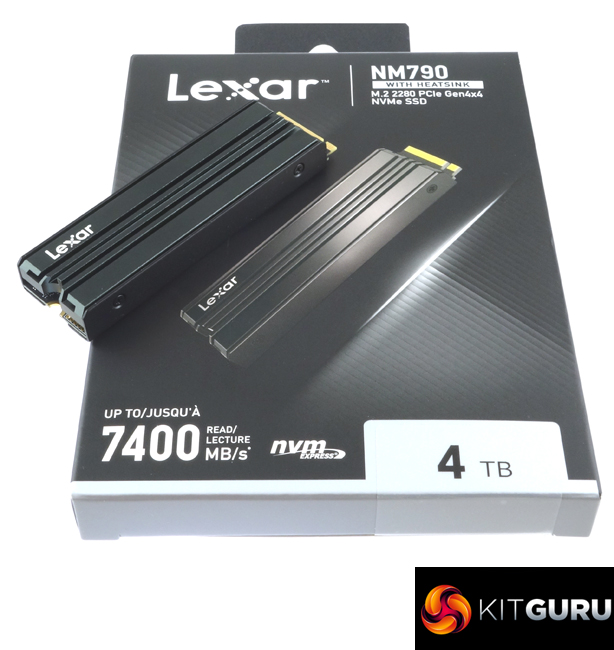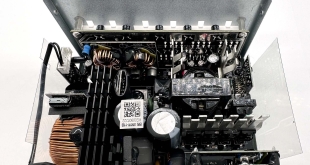When we reviewed the standard Lexar NM790 we were a little concerned about how hot the drive was getting in some of our benchmark tests, even though we didn't see signs of thermal throttling. Now Lexar has released a version of the Gen 4 NM790 with a factory-fitted heat sink and it's been interesting to see how well it works.
The standard NM790 comes in four capacites; 512GB, 1TB, 2TB and 4TB. For the heatsink version, Lexar has dropped the 512GB model from the line-up. The drive uses a simple-looking heatsink that is split into two parts, the heatsink and the cradle that holds the drive. The drive sits sandwiched between two thermal pads which run almost the complete length of the cooler. Four very small screws hold the two parts of the heatsink together.
Lexar's NM790 uses a controller that we rarely see, the four-channel Maxiotech MAP1602A. Built on a 12nm TSMC process with ARM Cortex-R5 architecture the MAP1602A is a DRAM-less design which uses Host Memory Buffer (HMB) 3.0 technology making use of system memory instead of a dedicated cache chip. The drive also makes use of Dynamic SLC cache writing technology. What sets this DRAM-less design apart from the majority of DRAM-less controllers is that it uses a 2400 MT/s interface speed.
The drive uses another rarely seen item, namely Longsys NAND. Longsys are Lexar’s parent company and the 4TB NM790 uses four 1TB 232-layer 3D TLC NAND packages.
Officially the 4TB version of Lexar's NM790 is rated at up to 7,400MB/s and 6,500MB/s for Sequential reads and writes respectively. Using the ATTO benchmark we couldn't quite hit those maximum figures with test results of 6,920MB/s and 5,940MB/s for reads and writes respectively. Switching over to the CrystalDiskMark 8 default benchmark saw confirmation of the official figures using with a best-read figure of 7,437MB/s with writes at 6,492MB/s. Using the 0 fill (compressible) settings saw the read performance rise to 7,470MB/s while the writes dropped back to 6,277MB/s.
There's no mention on the specification sheet for the Lexar NM790 with Heatsink about 4K random performance so the only clue we got was from the specs for the Maxiotech MAP1602A controller, the MAP1602A is rated as up to 1,000K for both reads and writes. When tested with our four treaded testing the best figures we saw were 631,118 IOPS (QD32) for reads and 497,150 IOPS (QD32). Breaking the read results down via QD, the NM790 with Heatsink is the fastest Gen 4 drive we've seen to date at QDs 2 and 32 and in the other highlighted QDs it was second fastest behind the standard NM790. When it came to random write performance the drive was slower than the standard drive through all the tested QDs.
Switching over to the Peak Performance Profile of CrystalDiskMark 8 we saw 4K read results much nearer the official figure with a best test result of 933,057 IOPS with a write figure bettering the official figure at 1,045,201 IOPS. Using the 0 fill (compressible) settings in the benchmark the read performance rose to 1,044,403 IOPS, confirming the official figure while the writes fell to 828,474 IOPS.
When we tested Lexar's NM790 we found it to be a very fast drive and in some of our tests, it is the fastest consumer drive we've seen to date but PCIe Gen4 drives are known for producing high temperatures when pushed hard and the standard 4TB Lexar NM790 was certainly no exception to that. During a couple of our test runs (CrystalDiskMark 8 Sequential QD1-32 T1 Write test and the ATTO tests), the drive hit 68 °C which is just 2°C away from the stated maximum operating temperature of 70°C. And that was with the drive under the chunky passive heatsink that our test motherboard, Gigabyte's AORUS X670E Xtreme uses.
When we ran the same two tests with the heatsink equipped NM790, (without any motherboard cooling) the CrystalDiskMark 8 Sequential QD1-32 T1 Write test peaked at 58°C while ATTO peaked at 57°C so around 10°C cooler than the standard drive. We also ran the standard drive in ATTO without any form of motherboard cooling which saw the drive hit 75°C, so in this scenario, the heatsink version ran 18°C cooler.
The NM790 is also supported by Lexar's SSD Dash. It might not have the funky GUI of some of its competitors' utilities but does have all the basics to help you maintain the drive including the ability to perform firmware updates, Secure Erase and data migration.
We found the 4TB version of Lexar's NM790 with Heatsink for £259.99 (inc VAT) on from Overclockers UK HERE.
Discuss on our Facebook page HERE.
Pros
- Heatsink design.
- Very fast drive.
- 4TB capacity.
- Endurance.
Cons
- Write speeds in some benchmark tests.
- Price against standard version.
KitGuru says: Lexar's NM790 is a seriously fast drive but it got rather hot when really pushed. The heatsink-equipped drive solves the issue, but you do have to pay around £50 over the price of the standard drive for the privilege.
 KitGuru KitGuru.net – Tech News | Hardware News | Hardware Reviews | IOS | Mobile | Gaming | Graphics Cards
KitGuru KitGuru.net – Tech News | Hardware News | Hardware Reviews | IOS | Mobile | Gaming | Graphics Cards





